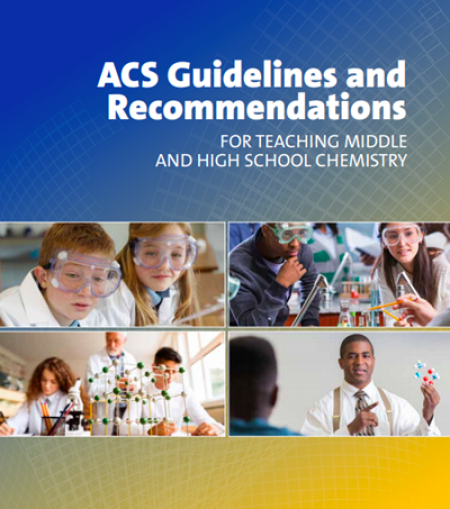Core Concepts
This section outlines the core concepts of chemistry that should be addressed in any comprehensive middle or high school curriculum. Each core idea is further broken into chemical principles, and suggested concepts to teach within those ideas are listed. The content does not need to be learned or shared in the order presented, and this is not an all-inclusive list.
- There are DCIs within the Earth & Space Sciences (ESS) as well as the Engineering, Technology & Applications of Science (ETS) standards that could be learned by students within a physical science or chemistry course. (For example, Global Climate Change is a DCI within ESS and could easily be addressed in a physical science or chemistry curriculum.)
- Teachers may have additional standards (such as the Common Core State Standards in English Language Arts & Mathematics) that they need to incorporate into their teaching practice.
- Teachers also may need to consult state and local standards to ensure all of the essential elements and assessment boundaries of their curriculum are included.

Middle School Core Concepts
Middle school teachers should be prepared to:
- introduce and support concepts of metric measurement (i.e. bar and line graphs);
- make detailed observations, using technology (like photos and slow motion video) to enhance observations, modeling, discourse, and conclusion writing.
High School Core Concepts
High school teachers should be prepared to:
- teach and reinforce additional science and mathematical skills, as well as critical reading and writing skills, to ensure all students needs are met;
- help students make connections between their prior knowledge and their new understanding.
What Are the Core Concepts?
These concepts are not isolated from each other. For example, reaction types can’t be taught without incorporating the concepts of atoms, ions, bonding, and chemical equations. To appropriately address the chemical principles (DCIs), as outlined in “A Framework for K-12 Science Education” and detailed in NGSS, the concepts should be taught using the three dimensions: science and engineering practices (SEPs), crosscutting concepts (CCCs), and DCIs. Appendices H and K of NGSS provide information about the nature of science and curriculum building.
Quick Reference: Core Concepts
- Matter
- Energy
- Motion and Stability
- Waves
Don’t forget to consult your state and local standards to ensure all of the essential elements and assessment boundaries of your curriculum is included.
The Chemistry Connection Across Science and Other Subject Areas
At both the middle and high school levels, students should be made aware of how chemistry relates to many other science fields. Also, informing students that chemistry is present in other subjects outside of science, such as history, math, and language arts, benefits students’ understanding of chemistry and may extend their appreciation for chemistry.
Likewise, the chemistry curriculum should not be limited to addressing only chemical principles. Rather, students should be exposed to the nature of science in general and how chemistry relates to other sciences and other subjects.
And of course, the core ideas of chemistry are not solely the domain of chemistry teachers. Teachers of other sciences should incorporate some of these topics, as should teachers of subjects outside of science to a lesser extent.
Examining, explaining, and understanding matter and its transformations at the various levels are accomplished best by allowing students to investigate. Investigation should be prominent in any science curriculum both at the middle and high school levels. Simple concepts that are widely accepted today, such as the percentage of oxygen in the air, were the result of many years of observations, questions, investigations, and experimentation.
Participating in the classroom means that students, too, will learn the practices of science and engineering, as suggested by NGSS. Experiments should be performed at both the middle and high school levels to generate data that will provide evidence and discourse for solving scientific questions and engineering problems. See more about investigations in the Laboratory section.
The Johnstone Triangle (Macroscopic, Atomic, Symbolic Representations of Chemistry)
One of the most important ideas about chemistry for students to learn is that what is perceived at the macroscopic level is a result of interactions at the particulate or atomic level, which can be represented symbolically. This way of explaining chemical phenomenon is known as Johnstone’s Triangle. This way of perceiving chemical processes has tremendous explanatory power and can help students understand some seemingly perplexing ideas. Chemists come up with explanations and predictions of the behavior of matter by observing how matter interacts on the macroscopic level. They can draw conclusions of what takes place on the atomic level and they represent those happenings symbolically.
For example, a fire—a macroscopic event—produces heat and light, and causes typically invisible air to be noticed. A chemist, at the atomic level, knows that oxygen molecules and carbon-rich molecules collide at high velocities to produce carbon dioxide and water, among other things. At the middle school level, students’ learning should focus on the conceptual and qualitative happenings on the macroscopic and atomic levels, and the chemistry content can be integrated into other scientific disciplines through developmentally and culturally appropriate story lines. At the high school level, extensions into symbolic and mathematical understandings of the chemistry content should be explored.
Effective instruction requires teachers to help students understand how phenomena relate at the particulate, symbolic, and macroscopic levels.
Reference:
- J. Chem. Educ. 1993, 70(9), 701-705. DOI: 10.1021/ed070p701.
ACS Guidelines and Recommendations
for Teaching Middle and High School Chemistry
An essential resource for middle and high school physical science and chemistry teachers, curriculum developers, principals, and other school administrators who support teachers in those roles.
Learn about the nature of instruction, the core ideas to teach, the physical instructional environment, safety, sustainability, and the professional responsibilities of teachers.


